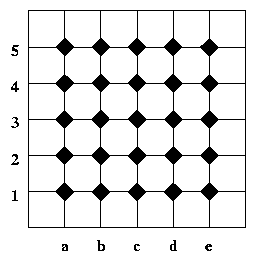
The game of Gothello bears some similarities to both Go and Othello. It is played on the intersections of a 5x5 board
by alternately placing dark ("black") and light ("white") stones
By convention, the 25 intersections are lettered a-e in the horizontal direction, and numbered 1-5 in the vertical direction, giving a unique name for each intersection, as shown above.
The players alternate in placing a stone on an intersection: black goes first. When a stone is placed in such a way that stones of the player on move plus the outer wall completely enclose, with no gaps, a group of the opponent's stones horizontally and vertically, the opponent's group is captured, and changes color to the color of the capturing player. A stone may be placed in any empty location on the board, except that placing a stone in such a way as to make the player on move form a captured group is prohibited.
One good way to think of these rules is in terms of "liberties". A "group" of stones is a collection of stones, any pair of which is connected by a series of horizontal and vertical moves.
The "margin" of a group is the set of board positions which are horizontally or vertically adjacent to the group. By definition, all the positions on the margin of a group are either of the opposing color or are empty.
The "liberties" of the group is the set of positions on the group margin which are empty.
In terms of liberties, the rules are as follows:
A player may pass at any time, and must pass when no legal moves are available. The game is over when both players have passed (in particular, when all playable positions are filled). The winner is the player with the most stones on the board at the end of the game: draws are possible due to the restriction on placement discussed above.
black moves to capture at b3
capturing two white pieces
Note that the left wall was part of the enclosure.
In the (unreachable) position shown
the white stones at e4, d3, and e2 are "safe". Neither black nor white can play e3 due to the capture restrictions described above. (This used to say "White may play e3 on any turn to complete the group.", which is wrong.)
Note that this is different from Go: here we have "one eye lives" rather than Go's "two eyes live" because of the differing capture rule. The rules here were chosen to work better on the smaller board, where it is difficult to create two "eyes".
In the (unreachable) position shown
the game is tied, and black is on move. However, black must pass, since the play at e3 is still illegal. White must also pass, since e3 is illegal for white now as well. (This used to say "White will play e3 and win", which is wrong.)
The game is drawn.
In the position shown,
neither black nor white can play e1. White cannot because it would cause the played group (all the stones on the board) to have zero liberties.
In the position shown,
black can play d1 and capture all of white's stones. This is because d1 is a legal move, and the white group adjacent to d1 will have zero liberties after it is made.
As in Go, it is important to create an "eye" to make safe formations. As in Othello, it is important to build "walls" that the opponent cannot easily capture.
As with any two-player alternating game, creating multiple simultaneous threats is effective.
First player has a strong advantage: someone should build an opening book.
An endgame engine would be very useful, as positions tend to fill out in predictable ways at the end, and a side without an eye may lose a large number of pieces on the last move.
Quickly computing and/or efficiently caching "groups" of connected stones for capture and liveness purposes may make a search go much faster.